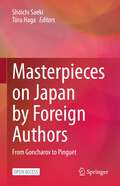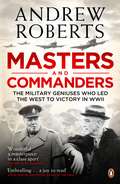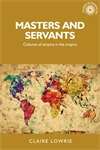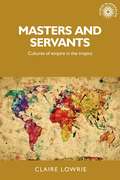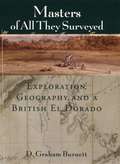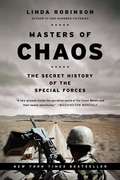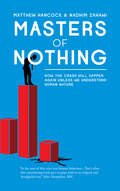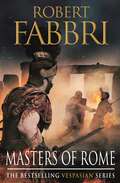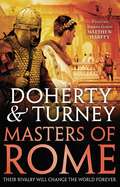- Table View
- List View
Masterpieces of American Architecture: Museums, Libraries, Churches and Other Public Buildings
by Willis Humphrey Church Edward Warren HoakFrom the golden age of American architecture comes this splendid survey, documenting scores of masterpieces built between 1900 and 1930. More than 260 illustrations include plans, sections, exterior and interior details, and photographs. A sampling of featured buildings include Lincoln Memorial, Boston Public Library, Tribune Tower, and Woolworth Building.
Masterpieces of Medieval Open Timber Roofs
by Raphael Brandon J. Arthur BrandonExcellently framed and designed, with bold, receding arches, the open timber roofs of the medieval period featured massive moldings, carved timbers, and intricate tracery. Today, these roofs are recognized for their striking beauty, rich ornamentation, and the consummate skills of the carpenters and builders who crafted them.This excellent reproduction of a rare nineteenth-century volume includes numerous full-page illustrations and construction details revealing a wealth of information on the major roof styles (tie-beam, trussed rafter, hammer-beam, and collar-braced) of medieval English churches. More than 50 illustrations of 34 English churches are included, among them the exquisite double hammer-beam roof of Knapton Church in Norwich, the richly ornamented roof over Trinity Chapel, Cirencester Church, in Gloucestershire, and the magnificent roof over Wymondham Church, in Norfolk, in which hammer-beams, boldly projecting into the nave, are exquisitely carved into figures of angels with expanding wings. These and many more masterly constructions are captured in the authors' own geometric and perspective drawings (done on-site), superbly reproduced here in detailed, highly accurate engravings. In addition to a wealth of pictorial detail, the authors also provide an informative general introduction to the major types of roof construction, as well as expert commentary on each individual roof, describing its distinguishing characteristics, ornament, measurements, and other details.Artists and illustrators will prize these beautifully rendered plates for their beauty and detail, while architects, antiquarians, and lovers of things medieval will appreciate the authenticity of the plates and the knowledgeable commentary of the architect-authors.
Masterpieces on Japan by Foreign Authors: From Goncharov to Pinguet
by Shōichi Saeki Tōru HagaThis open access book includes forty-one chapters about foreign observers’ discourses on Japan. These include a wide range of perspectives from the travelogues of curious visitors to academic theses by scholars, which offer us a broad spectrum of contents, reflecting a variety of attitudes toward Japan. The works were written during the period from the 1850s to the 1980s, a timespan during which Japan became, in stages, more open to the outside world after a long isolation under the Tokugawa shogunate. From the perspective of “Japanology,” one can discern three distinct periods of rising interest in the country from abroad. The first tide of such interest came shortly after the opening of Japan, when various foreign travelers, including those who could not be included in this book, came over and wrote down their impressions of the country—which was, for them, a land of mystery and mystique, which had just opened its doors to them. The second wave arose at the beginning of the twentieth century, just after the Russo-Japanese War, when Japan again generated a remarkable surge of interest as a “miracle” in Asia that had pulled off the wondrous feat of defeating a white superpower. The third wave was more recent, which took place from the late 1960s to the 1980s, a period of high economic growth when the “miracle” of Japan’s remarkable economic recovery from the defeat of World War II attracted enthusiastic and curious attention from the outside world once again. It is not the intention of this book to directly highlight such historical transitions, but these forty-two brilliant mirrors (forty-one chapters, including forty-two discourses), even when looked in casually, provide us with unexpected insights and various perspectives. Shōichi Saeki (1922–2016) was Professor Emeritus, the University of Tokyo. Tōru Haga (1931–2020) was Professor Emeritus, International Research Center for Japanese Studies.
Masters and Commanders: The Military Geniuses Who Led The West To Victory In World War II
by Andrew RobertsMasters and Commanders describes how four titanic figures shaped the grand strategy of the West during the Second World War. Each was exceptionally tough-willed and strong minded, and each was certain that he knew best how to win the war. Yet each knew that he had to win at least two of the others over in order to get his strategy adopted. The book traces the mutual suspicion and admiration, the rebuffs and the charm, the often explosive disagreements and wary reconciliations which resulted.
Masters and Lords: Mid-19th-Century U.S. Planters and Prussian Junkers
by Shearer Davis BowmanAmong the regional landed elites in the Western World of the mid-1800s, the two most formidable were the owners of slave plantations in the Southern states of the U.S. and the proprietors of manorial estates in the provinces of Prussian East Elbia. Masters and Lords surveys the economic, social, and political histories of the two classes from the seventeenth and sixteenth centuries respectively, and pays particular attention to planters during the secession crisis of 1860-61 and to Junkers during the revolutionary crisis of 1848-49. In the process, Bowman grapples with such ambiguous and contentious concepts as capitalism, conservatism, and paternalism. Despite very different labor systems, antebellum planters and contemporaneous Junkers alike presided over landed estates that functioned as both autocratic political communities and agricultural enterprises exporting valuable commodities to industrializing England. This book also highlights important geographic, demographic, and political contrasts between the South and East Elbia as regional societies. Bowman concludes that the crucial distinction between the two landed elites is to be found in the Junkers' militarist and estatist monarchism versus the planters' libertarian but racist republicanism.
Masters and servants: Cultures of empire in the tropics (PDF) (Studies in Imperialism)
by Claire LowrieMasters and servants explores the politics of colonial mastery and domestic servitude in the neighbouring British colonies of Singapore and Darwin. Through an exploration of master-servant relationships within British, white Australian and Chinese homes, this book illustrates the centrality of the domestic realm to the colonial project. It is the first comparative history of domestic service and British colonialism in the tropics, and highlights the important role which 'houseboys' played in colonial households in the tropics and the common preference for Chinese 'houseboys' throughout Southeast Asia. The book is meticulously researched, and draws from archives that have never been addressed in this way before. Its highly original and innovative approach, which combines comparative analysis with a focus on transcolonial connections, puts the book at the forefront of current postcolonial scholarship. The insights that Masters and servants provides into the domestic politics of colonial rule make this book essential reading for students and scholars of empire.
Masters and servants: Cultures of empire in the tropics (Studies in Imperialism)
by Claire LowrieMasters and servants explores the politics of colonial mastery and domestic servitude in the neighbouring British colonies of Singapore and Darwin. Through an exploration of master-servant relationships within British, white Australian and Chinese homes, this book illustrates the centrality of the domestic realm to the colonial project. It is the first comparative history of domestic service and British colonialism in the tropics, and highlights the important role which 'houseboys' played in colonial households in the tropics and the common preference for Chinese 'houseboys' throughout Southeast Asia. The book is meticulously researched, and draws from archives that have never been addressed in this way before. Its highly original and innovative approach, which combines comparative analysis with a focus on transcolonial connections, puts the book at the forefront of current postcolonial scholarship. The insights that Masters and servants provides into the domestic politics of colonial rule make this book essential reading for students and scholars of empire.
Masters and Servants in English Renaissance Drama and Culture: Authority and Obedience (Early Modern Literature in History)
by M. BurnettDrawing upon archival material as well as the drama, popular verse and pamphlets, this book reads representations of masters and servants in relation to key Renaissance preoccupations. Apprentices, journeymen, male domestic servants, maidservants and stewards, Burnett argues, were deployed in literary texts to address questions about the exercise of power, social change and the threat of economic upheaval. In this way, writers were instrumental in creating servant 'cultures', and spaces within which forms of political resistance could be realized.
Masters and Servants in Tudor England
by Alison SimAlthough life in Tudor was ordered in a strict hierarchy, service was common for all classes, and servants were not necessarily the lowest stratum in society. This book looks at the servant life in the Tudor period. It examines relations between servants and their masters, peering into the bedrooms, kitchens and parlours of the ordinary folk.
Masters And Servants On The Cape Eastern Frontier, 1760-1803 (African Studies #97 (PDF))
by Susan Newton-KingThis important study sheds light on the history of the South African interior during the eighteenth century, a time in which South Africa's specific variant of social discrimination first evolved. Susan Newton-King describes the tense and volatile relationship between European settlers and the indigenous Khoisan peoples. She probes beneath the surface to examine the underlying causes of the pervasive violence that marked relations between masters and servants in the eastern Cape. Focusing on the fate of the many women and children captured by Boer commandoes, she shows why they were assimilated to the condition of captive labour. She also provides a detailed account of the 'Bushman war' on the north-east frontier. Her analysis links the frontier economy and the markets and merchants of Cape Town, and indicates the overriding importance of the commercial policies of the Dutch East India Company.
The Masters and the Slaves: Plantation Relations and Mestizaje in American Imaginaries (New Directions in Latino American Cultures)
by A. Isfahani-HammondThis collection presents a comparative study of the impact of slavery on the literary and cultural imagination of the Americas, and also on the impact of writing on slavery on the social legacies of slavery's history. The chapters examine the relationship of slavery and master/slave relations to nationalist projects throughout the Americas - the ways in which a history of slavery and its abolition has shaped a nation's identity and race relations within that nation. The scope of the study is unprecedented - the book ties together the entire 'Black Atlantic', including the French and Spanish Caribbean, the US, and Brazil. Through reading texts on slavery and its legacy from these countries, the volume addresses the eroticization of the plantation economy, various formations of the master/slave dialectic as it has emerged in different national contexts, the plantation as metaphor, and the relationship between texts that use cultural vs biological narratives of mestizaje (being interracial). These texts are examined with the goal of locating the origins of the different notions of race and racial orders that have arisen throughout the Americas. Isfahani-Hammond argues that without a critical revisiting of slavery and its various incarnations throughout the Americas, it is impossible to understand and rethink race relations in today's world.
The Master's New Governess (Mills And Boon Historical Ser.)
by Eliza RedgoldA new position for the governess As mistress of Pendragon Hall?
Masters of All They Surveyed: Exploration, Geography, and a British El Dorado
by D. Graham BurnettChronicling the British pursuit of the legendary El Dorado, Masters of All They Surveyed tells the fascinating story of geography, cartography, and scientific exploration in Britain's unique South American colony, Guyana. How did nineteenth-century Europeans turn areas they called terra incognita into bounded colonial territories? How did a tender-footed gentleman, predisposed to seasickness (and unable to swim), make his way up churning rivers into thick jungle, arid savanna, and forbidding mountain ranges, survive for the better part of a decade, and emerge with a map? What did that map mean? In answering these questions, D. Graham Burnett brings to light the work of several such explorers, particularly Sir Robert H. Schomburgk, the man who claimed to be the first to reach the site of Ralegh's El Dorado. Commissioned by the Royal Geographical Society and later by the British Crown, Schomburgk explored and mapped regions in modern Brazil, Venezuela, and Guyana, always in close contact with Amerindian communities. Drawing heavily on the maps, reports, and letters that Schomburgk sent back to England, and especially on the luxuriant images of survey landmarks in his Twelve Views in the Interior of Guiana (reproduced in color in this book), Burnett shows how a vast network of traverse surveys, illustrations, and travel narratives not only laid out the official boundaries of British Guiana but also marked out a symbolic landscape that fired the British imperial imagination. Engagingly written and beautifully illustrated, Masters of All They Surveyed will interest anyone who wants to understand the histories of colonialism and science.
Masters of Battle: Monty, Patton and Rommel at War
by Terry BrightonIn the Second World War, Great Britain, the United States and Germany each produced one land force commander who stood out from the rest: Bernard Montgomery, George Patton and Erwin Rommel. These three armour-plated egos were the greatest generals of the war, and theirs was a very personal contest: the clash of mighty armies perceived as a bout between three men.All three were arrogant and flawed, yet with a genius for the command of men and an unrivalled enthusiasm for combat. All had spectacular success on the battlefield. But their explosive relationships with each other and with their political masters rivalled the pyrotechnics of their tank battles in determining the conduct and outcome of the war. Masters of Battle presents the Second World War as it was experienced by its three most flamboyant, controversial and influential commanders.
Masters of Bedlam: The Transformation of the Mad-Doctoring Trade
by Andrew Scull Charlotte Mackenzie Nicholas HerveyThrough an examination of the fascinating lives and careers of a series of nineteenth-century "mad-doctors," Masters of Bedlam provides a unique perspective on the creation of the modern profession of psychiatry, taking us from the secret and shady practices of the trade in lunacy, through the utopian expectations that were aroused by the lunacy reform movement, to the dismal realities of the barracks-asylums--those Victorian museums of madness within which most nineteenth-century alienists found themselves compelled to practice. Across a century that spans the period from an unreformed Bedlam to the construction of a post-Darwinian bio-psychiatry centered on the new Maudsley Hospital, from a therapeutics of bleeding, purging, and close confinement through the era of moral treatment and nonrestraint to a fin-de-siécle degenerationism and despair, men claiming expertise in the treatment of mental disorder sought to construct a collective identity as trustworthy and scientifically qualified professionals. This fascinating series of biographies answers the question: How successful were they in creating such a new identity?.Drawing on an extensive array of sources, the authors vividly re-create the often colorful and always eventful lives of these seven "masters of bedlam." Sensitive to the idiosyncrasies and peculiarities of each man's personal biography, the authors replace hagiographical ac-counts of the great men who founded modern psychiatry with fully rounded portraits of their struggles and successes, their achievements and limitations. In the process Masters of Bedlam provides an extremely subtle and nuanced portrait of the efforts of successive generations of alienists to carve out a popular and scientific respect for their specialty, and reminds us repeatedly of the complexities of nineteenth-century developments in the field of psychiatry.Originally published in 1996.The Princeton Legacy Library uses the latest print-on-demand technology to again make available previously out-of-print books from the distinguished backlist of Princeton University Press. These editions preserve the original texts of these important books while presenting them in durable paperback and hardcover editions. The goal of the Princeton Legacy Library is to vastly increase access to the rich scholarly heritage found in the thousands of books published by Princeton University Press since its founding in 1905.
Masters of Chaos: The Secret History of the Special Forces
by Linda RobinsonSpecial Forces soldiers are daring, seasoned troops from America's heartland, selected in a tough competition and trained in an extraordinary range of skills. They know foreign languages and cultures and unconventional warfare better than any U.S. fighters, and while they prefer to stay out of the limelight, veteran war correspondent Linda Robinson gained access to their closed world. She traveled with them on the frontlines, interviewed them at length on their home bases, and studied their doctrine, methods and history. In Masters of Chaos she tells their story through a select group of senior sergeants and field-grade officers, a band of unforgettable characters like Rawhide, Killer, Michael T, and Alan -- led by the unflappable Lt. Col. Chris Conner and Col. Charlie Cleveland, a brilliant but self-effacing West Pointer who led the largest unconventional war campaign since Vietnam in northern Iraq. Robinson follows the Special Forces from their first post-Vietnam combat in Panama, El Salvador, Desert Storm, Somalia, and the Balkans to their recent trials and triumphs in Afghanistan and Iraq. She witnessed their secret sleuthing and unsung successes in southern Iraq, and recounts here for the first time the dramatic firefights of the western desert. Her blow-by-blow story of the attack on Ansar al-Islam's international terrorist training camp has never been told before. The most comprehensive account ever of the modern-day Special Forces in action, Masters of Chaos is filled with riveting, intimate detail in the words of a close-knit band of soldiers who have done it all.
Masters of Chaos: The Secret History of the Special Forces
by Linda RobinsonSpecial Forces soldiers are daring, seasoned troops from America's heartland, selected in a tough competition and trained in an extraordinary range of skills. They know foreign languages and cultures and unconventional warfare better than any U.S. fighters, and while they prefer to stay out of the limelight, veteran war correspondent Linda Robinson gained access to their closed world. She traveled with them on the frontlines, interviewed them at length on their home bases, and studied their doctrine, methods and history. In Masters of Chaos she tells their story through a select group of senior sergeants and field-grade officers, a band of unforgettable characters like Rawhide, Killer, Michael T, and Alan -- led by the unflappable Lt. Col. Chris Conner and Col. Charlie Cleveland, a brilliant but self-effacing West Pointer who led the largest unconventional war campaign since Vietnam in northern Iraq. Robinson follows the Special Forces from their first post-Vietnam combat in Panama, El Salvador, Desert Storm, Somalia, and the Balkans to their recent trials and triumphs in Afghanistan and Iraq. She witnessed their secret sleuthing and unsung successes in southern Iraq, and recounts here for the first time the dramatic firefights of the western desert. Her blow-by-blow story of the attack on Ansar al-Islam's international terrorist training camp has never been told before. The most comprehensive account ever of the modern-day Special Forces in action, Masters of Chaos is filled with riveting, intimate detail in the words of a close-knit band of soldiers who have done it all.
Masters Of Empire (PDF): Great Lakes Indians And The Making Of America
by Michael A. McDonnell"In Masters of Empire, the historian Michael A. McDonnell reveals the vital role played by the native peoples of the Great Lakes in the history of North America. Though less well known than the Iroquois or Sioux, the Anishinaabeg, who lived across Lakes Michigan and Huron, were equally influential. Masters of Empire charts the story of one group, the Odawa, who settled at the straits between those two lakes, a hub for trade and diplomacy throughout the vast country west of Montreal known as the pays d'en haut. Highlighting the long-standing rivalries and relationships among the great Indian nations of North America, McDonnell shows how Europeans often played only a minor role in this history, and reminds us that it was native peoples who possessed intricate and far-reaching networks of commerce and kinship, of which the French and British knew little. As empire encroached upon their domain, the Anishinaabeg were often the ones doing the
Masters of Learned Ignorance: Eriugena, Eckhart, Cusanus (Variorum Collected Studies)
by Donald F. DuclowThe medieval Christian West's most radical practitioners of a Neoplatonic, negative theology with a mystical focus are John Scottus Eriugena, Meister Eckhart and Nicholas Cusanus. All three mastered what Cusanus described as docta ignorantia: reflecting on their awareness that they could know neither God nor the human mind, they worked out endlessly varied attempts to express what cannot be known. Following Pseudo-Dionysius the Areopagite, they sought to name God with symbolic expressions whose negation leads into mystical theology. For within their Neoplatonic dialectic, negation moves beyond reason and its finite distinctions to intellect, where opposites coincide and a vision of God's infinite unity becomes possible. In these papers Duclow views these thinkers' efforts through the lens of contemporary philosophical hermeneutics. He highlights the interplay of creativity, symbolic expression and language, interpretation and silence as Eriugena, Eckhart and Cusanus comment on the mind's work in naming God. This work itself becomes mystical theology when negation opens into a silent awareness of God's presence, from which the Word once again 'speaks' within the mind - and renews the process of creating and interpreting symbols. Comparative studies with Gregory of Nyssa, Pseudo-Dionysius, Anselm and Hadewijch suggest the book's wider implications for medieval philosophy and theology.
Masters of Learned Ignorance: Eriugena, Eckhart, Cusanus (Variorum Collected Studies)
by Donald F. DuclowThe medieval Christian West's most radical practitioners of a Neoplatonic, negative theology with a mystical focus are John Scottus Eriugena, Meister Eckhart and Nicholas Cusanus. All three mastered what Cusanus described as docta ignorantia: reflecting on their awareness that they could know neither God nor the human mind, they worked out endlessly varied attempts to express what cannot be known. Following Pseudo-Dionysius the Areopagite, they sought to name God with symbolic expressions whose negation leads into mystical theology. For within their Neoplatonic dialectic, negation moves beyond reason and its finite distinctions to intellect, where opposites coincide and a vision of God's infinite unity becomes possible. In these papers Duclow views these thinkers' efforts through the lens of contemporary philosophical hermeneutics. He highlights the interplay of creativity, symbolic expression and language, interpretation and silence as Eriugena, Eckhart and Cusanus comment on the mind's work in naming God. This work itself becomes mystical theology when negation opens into a silent awareness of God's presence, from which the Word once again 'speaks' within the mind - and renews the process of creating and interpreting symbols. Comparative studies with Gregory of Nyssa, Pseudo-Dionysius, Anselm and Hadewijch suggest the book's wider implications for medieval philosophy and theology.
Masters of Make-Up Effects: A Century of Practical Magic
by Howard Berger Marshall JuliusDive into the fascinating world of movie make-up effects with this stunning illustrated oral history of the art form. Masters of Make-Up Effects is a celebration of make-up artists and acclaimed make-up effects from the world of film and television. Authors Howard Berger and Marshall Julius have gleaned untold stories from the sets of cult classics (Planet of the Apes, An American Werewolf in London, The Thing), fan-favourite film and TV franchises (Star Trek, Star Wars, Harry Potter and the MCU) and modern blockbusters like Dune to chart the fascinating evolution of an industry.Lavishly illustrated with hundreds of behind-the-scenes photos, many of which have never before been seen in print or on social media, it showcases some of the most iconic make-up effects of all time, while revealing how they came to be in the artists' own words.Featuring a foreword by Guillermo del Toro, an afterword by Seth MacFarlane, and contributions from more than 50 make-up effects legends, as well as iconic actors including Doug Jones, Robert Englund, James McAvoy and Doug Bradley, and directors Mick Garris and John Landis, Masters of Make-Up Effects is the most complete book on movie make-up history ever assembled, and a must read for cinema fans everywhere.
Masters of Nothing: How the crash will happen again unless we understand human nature
by Matthew HancockBehaviour is important. Whether this be the behaviour of those who saw it coming, or of those who constantly berated them. The behaviour of those who rode the boom and switched at the tipping point to ride the bust, or the behaviour of those who held on to their principled as the system collapsed around them. It was human behaviour after all, that led us to construct a bubble nobody suspected was dangerous, yet nonetheless would burst with disastrous consequences. Contrary to the views of many before the crash the cycle is inevitable - you cannot eliminate boom and bust. In a boom the bullish are promoted whilst the cautious are overlooked, reinforcing the cycle. This factor is generally ignored by the beautiful but flawed models of economic analysts. Since we cannot abolish the cycle, we must ensure that busts are not so dangerous in the future. The policy solutions are there if we're brave enough, from changing incentives, and creating fiscal and financial regulators with clout and discretion, through to changing corporate governance and shifting the power of executives.
Masters of Rome (Vespasian #5)
by Robert FabbriRome, AD 51: After eight years of resistance Vespasian captures Rome's greatest enemy, the British warrior Caratacus. But even Vespasian's victory cannot remove him from politics. Emperor Claudius is a drunken fool and Narcissus and Pallas, his freedmen, are battling for control of his throne. Separately, they decide to send Vespasian east to Armenia to defend Rome's interests. Rumours abound that Claudius' wife Agrippina is involved in a plot to destabilise the East. Meanwhile, a new Jewish cult is flourishing and its adherents refuse to swear loyalty to the Emperor. In Armenia, Vespasian is captured. Immured in the oldest city on earth, how can he escape? And is a Rome ruled by Agrippina any safer than a prison cell? THE FIFTH INSTALMENT IN THE VESPASIAN SERIES______________________________________________Don't miss Robert Fabbri's epic new series Alexander's Legacy
Masters of Rome (Rise of Emperors #2)
by Simon Turney Gordon DohertyTheir rivalry will change the world forever.As competition for the imperial throne intensifies, Constantine and Maxentius realise their childhood friendship cannot last. Each man struggles to control their respective quadrant of empire, battered by currents of politics, religion and personal tragedy, threatened by barbarian forces and enemies within.With their positions becoming at once stronger and more troubled, the strained threads of their friendship begin to unravel. Unfortunate words and misunderstandings finally sever their ties, leaving them as bitter opponents in the greatest game of all, with the throne of Rome the prize.It is a matter that can only be settled by outright war...'A page turner from beginning to end... A damn fine read' Ben Kane, author of Lionheart (on Sons of Rome)'The Rise of Emperors series is first-rate Roman fiction. Doherty and Turney each breathe life into their respective characters with insight and humanity' Matthew Harffy, author of Wolf of Wessex'A nuanced portrait of an intriguing emperor' The Times (on Turney's Commodus)'A meticulously researched and vivid reimagining of an almost forgotten civilisation' Douglas Jackson, author of Hero of Rome (on Doherty's Empires of Bronze)'An intriguing and highly polished piece of historical fiction' James Tivendale from Grimdark (on Sons of Rome)
Masters of Rome Collection Books I - V: First Man in Rome, The Grass Crown, Fortune's Favourites, Caesar's Women, Caesar
by Colleen McCulloughThe world cowers before its legions, but the fate of Rome hangs in the balance. From the marbled columns of the Senate to the squalid slums of the Subura, the city is about to be plunged into a conflict that will set rich against poor, Roman against Italian, father against son, a conflict destined to destroy the Republic but leave, in its stead, an Empire. From the seven hills of Rome to the Sahara desert, from Britannia to Bithynia, here is the stuff of legend: unbearable cruelty, martial brilliance, murderous ambition and heroic destiny. Colleen McCullough's epic MASTERS OF ROME captures the soul of Rome in a way no other writer has ever managed. Included in this box set are the novels: THE FIRST MAN IN ROME.THE GRASS CROWN.FORTUNE'S FAVOURITES.CAESAR'S WOMEN.CAESAR. Please note: This ebook contains all the original maps and illustration.


